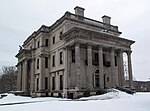Vanderbilt Lane Historic District
Federal architecture in New York (state)Historic districts in Dutchess County, New YorkHistoric districts on the National Register of Historic Places in New York (state)Hyde Park, New YorkNRHP infobox with nocat ... and 5 more
National Register of Historic Places in Dutchess County, New YorkShingle Style architecture in New York (state)Streets in New York (state)U.S. Route 9Use mdy dates from August 2023

The Vanderbilt Lane Historic District is a small area along the street of the same name, just east of US 9 in Hyde Park, New York, United States. It was used for the farm functions of the nearby estate of Walter Langdon and, later, Frederick Vanderbilt. Most of its buildings date to the turn of the 19th century, with one remaining from the 1830s. Many of its buildings and infrastructure remain intact. It is one of only two estate farm complexes on the east side of the Hudson that has not been razed and redeveloped. In 1993 it was recognized as a historic district and added to the National Register of Historic Places.
Excerpt from the Wikipedia article Vanderbilt Lane Historic District (License: CC BY-SA 3.0, Authors, Images).Vanderbilt Lane Historic District
Vanderbilt Lane,
Geographical coordinates (GPS) Address Nearby Places Show on map
Geographical coordinates (GPS)
| Latitude | Longitude |
|---|---|
| N 41.801944444444 ° | E -73.936666666667 ° |
Address
Vanderbilt Lane 6
12538
New York, United States
Open on Google Maps








